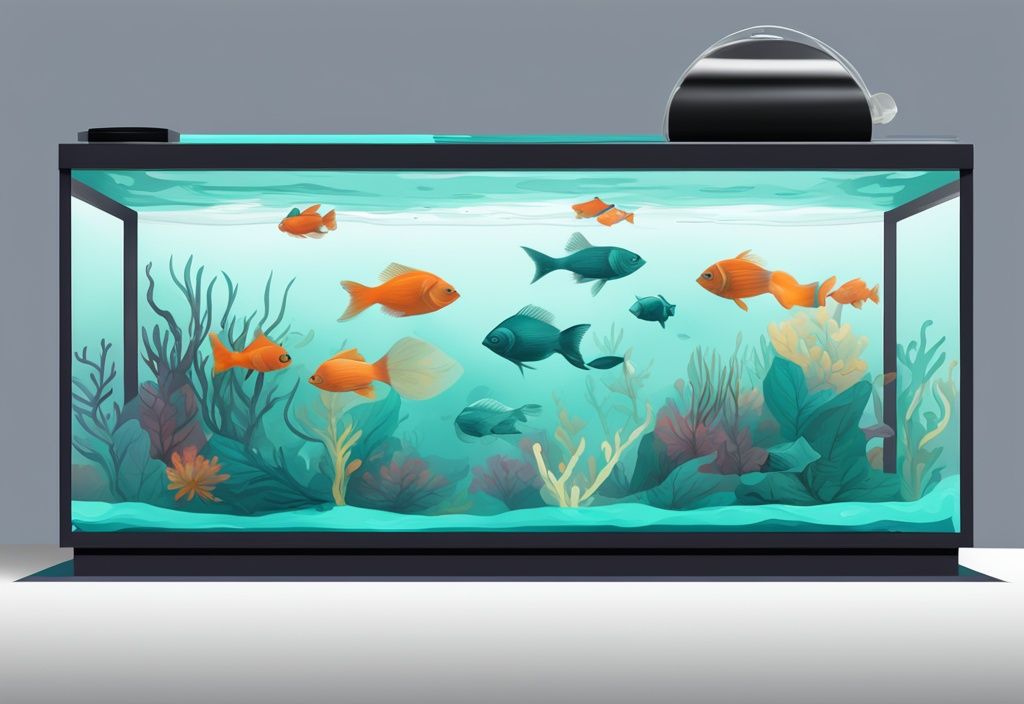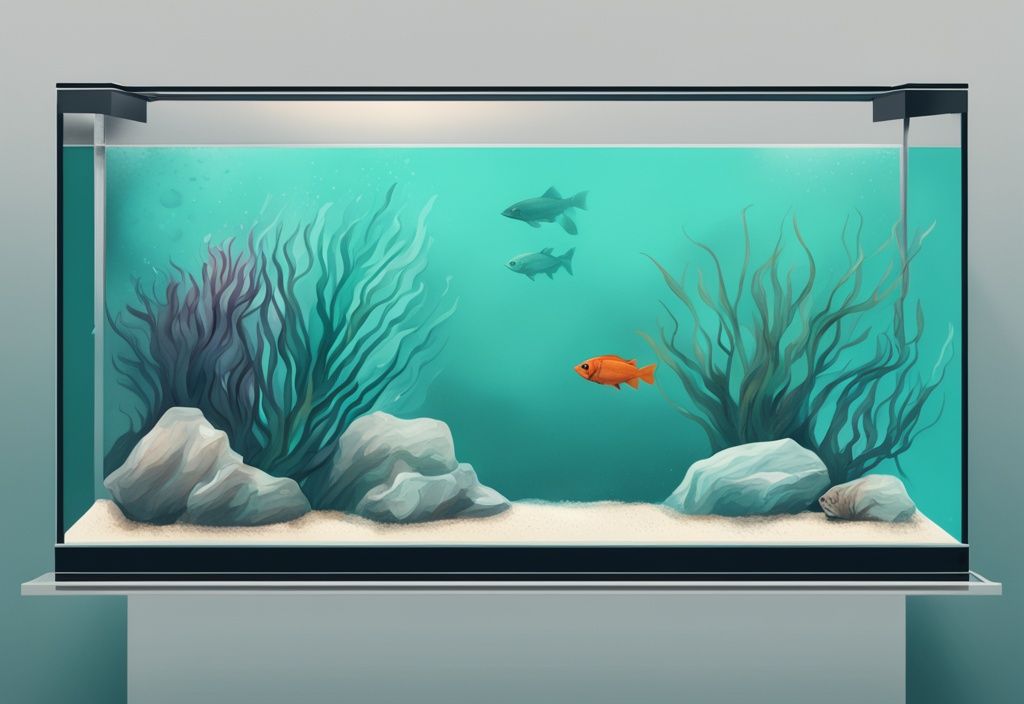Imagine peering into your fish tank and witnessing the pristine clarity of water, swimming with healthy, vibrant aquatic creatures – this is the power of a high-quality carbon filter. As a marine biologist for over two decades, I, Dr. Melanie Rivers, can attest to the significant role carbon filters play in maintaining a thriving aquarium environment.
However, with the plethora of carbon filters on the market, choosing the best one can seem a bit daunting, don’t you think? Don’t worry, my dear aquarium aficionados. This article will guide you on your journey, reviewing the top-rated carbon filters of 2024 and providing maintenance tips honed from years of experience.
Let’s unravel the science together, navigate the sea of choices, and ensure those beloved aquatic companions of yours bask in the cleanest, healthiest environment possible. Stay with me, and let’s commence this exciting exploration.
Importance of Carbon Filters in Fish Tanks
Carbon filters play a fundamental role in creating a healthy and vibrant fish tank environment. They are indispensable tools for removing impurities and ensuring the safety of your aquatic friends. Let’s delve deeper into how these filters contribute to aquarium health and efficiency.
The Role of Carbon Filters in Aquarium Health
Maintaining a clean and healthy fish tank environment is paramount for the wellbeing of your aquatic life, and choosing the best carbon filter for a fish tank can make a significant difference. Activated carbon filters play a crucial role in removing harmful organic wastes, chlorine, some heavy metals, and residual medications from the water. By effectively eliminating these impurities, they ensure that the aquarium remains a safe and conducive habitat for fish and other aquatic organisms.
The consistent use of high-quality activated carbon filters contributes significantly to improved water clarity and overall quality. The reduction in organic waste not only helps in maintaining clear water but also addresses potential algae issues that can arise from nutrient accumulation. Additionally, some fish species, such as Apistogramma cacatuoides, are particularly sensitive to toxins, underlining the necessity of using carbon filters to provide a healthier environment.
Regular monitoring of water parameters, including ammonia, nitrites, nitrates, and pH levels, is essential to identify any irregularities that may indicate the need for additional filtration. By combining carbon filters with rigorous parameter checks, aquarists can better maintain the delicate balance required for a thriving aquatic ecosystem.
How Carbon Filters Work in Fish Tanks
The effectiveness of activated carbon in fish tanks is primarily due to a process known as adsorption. During this process, impurities in the water are trapped within the porous structure of the activated carbon. This makes the best carbon filter for a fish tank a highly effective tool for quickly neutralizing harmful substances.
High-quality activated carbon is often granulated to maximize its surface area, enhancing its absorption capacity.
Premium carbon, recognized for its high-grade composition, excels at rapidly trapping contaminants, providing a cleaner water environment for the fish. This superior cleaning process eliminates trapped ash from the carbon’s pores, ensuring the filter media remains efficient and requires less frequent replacements.
The large internal surface area of high-grade activated carbon ensures the rapid adsorption of a variety of dissolved pollutants, including yellow-brown tints, toxins, chlorine, most medications, and some heavy metals. Moreover, the best carbon filter for a fish tank should be easy to rinse, producing minimal black dust to reduce cleanup efforts and enhance usability.
Considerations When Purchasing the Best Carbon Filter
Selecting the best carbon filter for a fish tank involves understanding several key factors to ensure an optimal aquatic environment. From tank size to maintenance routines, each aspect plays a crucial role in maintaining water clarity and overall tank health.
How Fish Tank Size Affects Filter Choice
When selecting the best carbon filter for a fish tank, the first consideration should be the size of the tank. Larger tanks typically require filters with higher capacity to effectively manage the greater volume of water and the increased organic load.
For extensive systems, bulk carbon options are not only cost-effective but also ensure uniform quality in filtration. Additionally, the use of fine mesh bags can facilitate the containment and replacement of carbon, making maintenance more convenient. It’s also beneficial to opt for smaller carbon fragments as these offer a larger surface area for adsorption, enhancing the filter’s efficiency by minimizing gaps and maximizing the contact between water and the carbon material.
Understanding Filter Capacity
Understanding the capacity of a filter is crucial as it directly impacts the filter’s performance and the overall health of the tank’s environment. The right filter size ensures optimal living conditions for fish and other aquatic organisms.
Key factors influencing a filter’s capacity include water flow rate, the organic load within the tank, and the quantity of carbon used. An appropriately sized carbon filter maintains effective water clarification and toxin removal, thereby supporting a stable aquatic ecosystem. High-quality carbon with superior adsorption capacity can manage larger amounts of impurities and remain effective over extended periods.
Necessity of Filter Maintenance
Regular maintenance is essential to keep the best carbon filter for a fish tank functioning at its peak. Frequent monitoring and maintenance of the carbon filter system ensure that the aquarium environment remains healthy and conducive for aquatic life.
Activated carbon should be replaced regularly, typically on a monthly basis, to maintain its efficacy in clearing toxins and improving water clarity. Proper cleaning techniques, such as rinsing the carbon media before use to remove dust and particles, can also extend the lifespan of the filter. Consistent maintenance routines prevent the buildup of contaminants, ensuring the filter continues to provide a clean and healthy environment for the fish.
Best Carbon Filters for Your Fish Tank: Top Brands Reviewed
Choosing the best carbon filter for a fish tank is crucial for maintaining a clean and healthy aquatic environment. In this review, we delve into the top brands known for their exceptional performance, ease of use, and efficiency in removing pollutants and toxins from your aquarium.

Detailed Review: Fluval Carbon Filter
The Fluval Carbon Filter stands out as one of the best carbon filters for a fish tank due to its exceptional chemical filtration capacity. Its high-grade, research-grade carbon composition ensures that it can effectively trap a wide range of contaminants and toxins, making it an indispensable tool for maintaining a clean and healthy aquarium.
What sets the Fluval Carbon Filter apart is its premium carbon, which is highly efficient in quickly removing dissolved pollutants. This includes troublesome yellow-brown tints, harmful toxins, chlorine, leftover medications, and even some heavy metals. The large internal surface area of the carbon means that there’s ample room for adsorption, significantly improving the clarity and safety of your tank water.
In-Depth Analysis: Marineland Black Diamond Activated Carbon Filter
The Marineland Black Diamond Activated Carbon Filter is another top contender when it comes to the best carbon filter for a fish tank. This filter is particularly noted for its ability to remove water discoloration, persistent odors, and various water impurities.
A standout feature is its easy-to-rinse design that produces minimal black dust, making maintenance less of a hassle. Additionally, the extended lifespan of this filter can be attributed to its enhanced cleaning process, which exposes more surface area inside each granule. This results in better pollutant trapping and more efficient use over time, offering both convenience and high performance.
Comprehensive Evaluation: API Activated Filter Carbon
API Activated Filter Carbon is highly regarded for its capability to optimize aquarium water quality. With its notably large pores, this carbon filter is designed to maximize the absorption of pollutants commonly found in aquariums. This makes it a prime choice for aquarists seeking the best carbon filter for a fish tank.
The smaller fragments of this carbon filter provide a greater surface area for adsorption and pack tightly to minimize gaps, ensuring thorough removal of contaminants. Furthermore, the inclusion of a reusable fine mesh media bag adds practicality, allowing for each piece to be securely contained while facilitating good water flow throughout the aquarium.
Thorough Assessment: Seachem Matrix Carbon
The Seachem Matrix Carbon is distinguished by its ultrahigh porosity and minimal impact on pH levels, positioning it as one of the best carbon filters for a fish tank. This filter excels in its ability to rapidly adsorb a wide array of dissolved pollutants, enhancing the overall quality and clarity of tank water.
A superior cleaning process is employed to remove trapped ash from the carbon pores, leading to cleaner and more efficient usage. The significant internal surface area of Seachem Matrix Carbon ensures effective removal of yellow-brown tints, toxins, chlorine, most medications, and various heavy metals. This filter’s unique attributes make it a smart choice for maintaining a pristine and safe aquatic environment.
Maintaining and Replacing Your Carbon Filter: Expert Tips
A well-maintained carbon filter is pivotal for a thriving aquarium. Let’s delve into the nuances of recognizing when your carbon filter needs a change and how to maintain it effectively.
Signs Your Carbon Filter Needs Replacing
Recognizing when to replace your carbon filter is essential for a healthy fish tank. Think of it as the backbone of your aquarium’s cleanliness. A telltale sign is reduced water clarity. If your tank remains cloudy despite regular maintenance, it’s a red flag that your carbon filter might be on its last legs.
Persistent, unpleasant odors are another significant indicator. A fully functional carbon filter should neutralize nasty smells. Moreover, if there’s a noticeable spike in impurities like ammonia, nitrites, or nitrates, it’s time to consider a replacement. Consistently replacing the carbon media, typically on a monthly basis, is recommended to keep toxins at bay and preserve water clarity.
Proper Cleaning and Maintenance Techniques for Carbon Filters
Effective cleaning and maintenance can dramatically extend the lifespan of your carbon filter. Think of rinsing a new activated carbon filter as a preparatory ritual. It removes any dust or particles accumulated during packaging and handling, which could otherwise cloud your tank’s pristine waters.
Carbon filters are versatile and fit snugly into various systems, including HOB (Hang-On-Back) filters. To maintain optimal performance, a light rinse under aquarium-safe water does wonders. Consistent maintenance practices not only prolong the filter’s efficiency but also significantly enhance water clarity and quality.
In essence, the best carbon filter for a fish tank is one that is diligently maintained and timely replaced. By keeping these tips in mind, your aquatic ecosystem can thrive, mirroring the balance and beauty of nature itself.
Pros and Cons of Carbon Filters in Aquariums
When considering the best carbon filter for a fish tank, it’s essential to understand both the advantages and potential limitations. Below, we’ll explore the significant benefits and common concerns associated with using carbon filters in aquariums.
Benefits of Using Carbon Filters
Maintaining a pristine and healthy fish tank environment becomes much more manageable with the best carbon filter for a fish tank. One significant benefit of using activated carbon filters is their remarkable efficiency in removing organic wastes, chlorine, heavy metals, and leftover medications from the water. These substances can be harmful to fish if left unchecked.
This filtration process goes a long way in improving water clarity and overall quality. Clean, clear water not only makes your tank visually appealing but also promotes the well-being of its aquatic inhabitants. Imagine glancing into a crystal-clear tank where your fish thrive — that’s the kind of environment the best carbon filters help you achieve.

Additionally, carbon filters play a crucial role in addressing algae issues. They help maintain cleaner water conditions, which are less favorable for algae growth. A top-tier carbon filter, especially one made from premium-grade materials, can quickly and effectively trap harmful contaminants and toxins. This not only preserves water clarity but also ensures a safer habitat for sensitive fish species.
Given these combined advantages, an activated carbon filter stands out as an integral component for any fish tank setup aiming for optimal health and cleanliness. It’s like giving your underwater friends the gift of a balanced and harmonious living space.
Counter Arguments and Limitations of Carbon Filters
Despite their numerous benefits, some aquarists raise valid concerns about the use of carbon filters. A frequently mentioned issue is the ongoing maintenance and cost associated with regular replacement of the carbon media. Ensuring its effectiveness means staying on top of this replacement schedule. High-quality carbons like ROX 0.8 can offer better long-term results, but they do come with a higher upfront cost.
Water flow and organic load are also critical factors that can impact the performance and lifespan of carbon filters. For smaller tanks or those seeking a more practical setup, alternatives like Chemipure Blue might be preferred. While these alternatives combine high-quality carbon with ease of use, they don’t match the filtration capacity of bulk carbon options.
Moreover, it’s important to remember that a carbon filter — no matter how efficient — cannot entirely replace the necessity of regular water parameter monitoring and maintenance. Routine tank care remains vital. Recognizing these limitations can help aquarists select the best carbon filter for their fish tank, tailored to meet their specific needs while adequately addressing potential drawbacks.
Choosing the Right Carbon Filter for Your Specific Needs
Finding the best carbon filter for a fish tank requires understanding different needs, whether you’re managing a large tank or one bustling with a high fish population. Let’s deep dive into tailored solutions for both scenarios.
The Ideal Carbon Filter for Larger Tanks
When selecting the best carbon filter for a fish tank, especially for larger setups, bulk carbon options are often the most economical and effective choice. Bulk carbon not only reduces overall costs but also ensures long-term consistency and quality across extensive use.
Among the bulk carbon types, BRS ROX 0.8 carbon stands out due to its small grain size. This finer grain enhances its surface area, making it exceptionally efficient at adsorbing contaminants and polishing the water. This high efficiency translates into longer-lasting performance, minimizing the need for frequent replacements.
When using carbon in reactors, it’s crucial to ensure proper flow and monitor water parameters regularly. Adequate water flow ensures that all water passing through the tank is effectively filtered, maintaining optimal water quality and clarity.
Picking the Right Carbon Filter for Tanks with More Fish
Choosing the best carbon filter for a fish tank with a high fish population involves careful consideration of several factors. Tank size, filter capacity, the type and number of fish, as well as maintenance requirements, all play critical roles in determining the most suitable carbon filter.
For tanks with more fish, smaller carbon fragments are advantageous. They offer a larger surface area for adsorption and fit snugly together, minimizing gaps through which impurities might escape. Consistent use of high-quality activated carbon filters is particularly beneficial in these scenarios, as they significantly enhance water clarity and quality. By efficiently removing organic wastes, chlorine, and other harmful substances, these filters maintain a healthy environment, ensuring the well-being of all aquatic life.
Maximize Efficiency of Your Carbon Filter: Essential Guide
To maintain clear, toxin-free water in your fish tank, your carbon filter needs to perform at its best. The following sections will guide you through everything you need to know to maximize your filter’s efficiency.
Maintaining High Performance of Your Carbon Filter
Ensuring the **best carbon filter for a fish tank** provides optimal performance is key to creating a balanced aquatic environment.
An essential practice is selecting the correct filter size. This choice directly impacts water clarity and helps reduce harmful substances, benefiting your aquatic life. For tips on maintaining a healthy environment, learn how to change the water in your fish tank effectively.
Regularly replacing the carbon media, ideally on a monthly basis, maintains its efficacy in removing toxins and keeping water pristine. A commonly overlooked but crucial step is pre-rinsing the activated carbon. By rinsing the carbon media before use, you eliminate dust and particles accumulated during packaging, preventing these impurities from entering your tank.
Consistent maintenance, such as this, extends the lifespan of your filter and guarantees it continues to function efficiently. These practices are paramount in sustaining a healthy, thriving aquatic habitat.

Combining Carbon Filters with Other Filtration Methods
Incorporating the **best carbon filter for a fish tank** into a diverse filtration system can significantly enhance water quality. Carbon filters work excellently alongside mechanical and biological filtration, each method complementing the others to create a synergistic effect. It’s crucial to remember, though, that carbon filters alone cannot handle all filtration needs.
Routine tasks like water changes and substrate cleaning are indispensable. These activities ensure a complete and effective filtration process. Tailoring the use of carbon filters to suit the specific conditions of your fish tank is critical for optimal results.
The versatility of carbon filters allows them to be integrated into various systems, including Hang-On-Back (HOB) filters. This adaptability ensures that all tank inhabitants benefit from a thorough and comprehensive filtration process, maintaining the ideal environment.
By adhering to these guidelines, you not only enhance the efficiency of your carbon filter but also promote a healthier and more vibrant aquatic ecosystem.
Conclusion: Making the Best Choice for Your Fish Tank
Ensuring your fish tank remains a haven for aquatic life involves a meticulous approach to water cleanliness and quality. One of the most effective tools in achieving this is the carbon filter. The best carbon filter for a fish tank acts as a critical component in maintaining the health and vibrancy of your aquarium.
Activated carbon filters are renowned for their ability to adsorb impurities from the water. They trap organic wastes, chlorine, some heavy metals, and residual medications, which, if left unchecked, could harm your fish. The result is not only a cleaner environment but also significantly improved water clarity. Clear water is not just about aesthetics; it plays an essential role in the overall wellbeing of the aquarium’s inhabitants.
Choosing the right carbon filter depends on various factors including the size of the tank and the number of fish. Larger tanks might require bulk carbon options to save costs and maintain consistent quality. Smaller carbon fragments are beneficial due to their greater surface area for adsorption, ensuring there are no gaps where pollutants can escape. Consistent monitoring of water parameters such as ammonia, nitrites, nitrates, and pH will help in determining the effectiveness and necessity of the carbon filter being used.
If you’re dealing with high ammonia levels, you might find our guide on how to lower ammonia in fish tank useful.
Maintenance of the carbon filter is another critical aspect. Regular replacement of the filter media, typically monthly, is advised to ensure it remains effective in removing toxins and maintaining water clarity. Proper cleaning techniques, such as rinsing activated carbon before use, can prevent dust and particles from clouding the water, ensuring the filter operates at peak efficiency.
In conclusion, the best carbon filter for a fish tank is indispensable for preserving aquatic life. It promotes a clean and healthy environment by efficiently removing impurities and toxins. Careful selection, regular monitoring, and maintenance of carbon filters can significantly contribute to the clarity and quality of water in your fish tank, ensuring your aquatic friends thrive.
Frequently Asked Questions (FAQ) About The Best Carbon Filters
In this section, explore the essentials of using the best carbon filter for a fish tank. From replacement frequency to installation tips, get expert insights on maintaining a healthy aquatic environment.
How Often Should I Replace My Carbon Filter?
To keep your fish tank thriving, it’s vital to regularly replace the carbon media—typically on a monthly basis. This practice maintains the filter’s effectiveness in removing toxins and improving water clarity. Imagine it like changing the oil in your car; regular maintenance ensures peak performance and longevity.
Will a Carbon Filter Remove All Types of Toxins?
Activated carbon filters excel at adsorbing impurities due to their porous structure, making them a popular choice in aquariums for decades. For a deeper understanding of what activated carbon can remove and its relevance in modern filtration systems, check out this informative article on activated carbon in the aquarium. These filters efficiently remove organic wastes, chlorine, some heavy metals, and even lingering medications. Hence, they’re often considered the best carbon filter for a fish tank. Think of it as a sponge soaking up unwanted substances, leaving your tank water cleaner and healthier.
Any Fish Species That Shouldn’t Have Carbon Filters?
While most fish benefit from carbon filters, some species, like Apistogramma cacatuoides, are particularly sensitive to toxins. In these cases, carbon filters are not just beneficial but essential. Beyond detoxification, these filters also enhance water clarity and can help mitigate algae issues.
What’s the Best Way to Install a Carbon Filter?
Installing a carbon filter is generally straightforward. These filters can be inserted into most filtration systems, including HOB (Hang-On-Back) filters, using fine mesh bags. This setup not only helps contain the carbon but also simplifies the process of replacing or cleaning it. It’s much like using a tea infuser: compact, efficient, and easy to manage.
Do Carbon Filters Affect Aquarium pH Levels?
One concern among aquarists is whether carbon filters alter water pH levels. Products like Seachem Matrix Carbon, known for their ultrahigh porosity, have minimal impact on pH. Consistently using these activated carbon filters can greatly enhance water clarity and quality without disturbing the delicate pH balance, akin to finding the perfect coffee blend that provides clarity and taste without bitterness.
